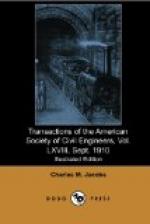ENGINEERING ORGANIZATION.
Mr. Rea, Vice-President, has general charge of all matters involved in the designing and execution of the project.
The Board of Engineers.—Before the beginning of the work, the Management appointed a Board of Engineers which was instructed to examine into the New York Tunnel Extension project; to pass upon the practicability of the undertaking; to determine upon the best plans for carrying it out; to make a careful estimate of its cost; and, if the work was undertaken, to exercise general supervision over its construction.
President Cassatt’s letter appointing the Board contains the following further instructions:
“You are requested to procure all additional information that may be needed, sparing neither time nor any necessary expense in doing so, for I am sure it is not necessary for me to say that, in view of the magnitude and great cost of the proposed construction, and of the novel engineering questions involved, your studies should be thorough and exhaustive, and should be based upon absolute knowledge of the conditions.”
The Board was organized on January 11th, 1902, when it held its first session, and continued in the performance of its duties until April 30th, 1909, when it was dissolved, its work having been completed.
The Board held regular and special sessions to receive progress reports from the Chief Engineers in direct charge of construction, and to consider questions relating to the plans and details of the work submitted by its members or referred to it by the Management. It then reported its conclusions to the Vice-President for approval before the work was undertaken.
The Management earnestly impressed upon the Board throughout the whole period of its labors, that the Tunnel Extension and facilities were to be designed and constructed without regarding cost as a governing factor, the main considerations being safety, durability, and proper accommodation of the traffic. No expenditure tending to insure these conditions was to be avoided.
The Board, when organized, was composed as follows: Col. Charles W. Raymond, Corps of Engineers, U. S. Army, Chairman; Messrs. Gustav Lindenthal, Charles M. Jacobs, Alfred Noble, and William H. Brown.
Mr. George Gibbs was appointed a member of the Board on April 9th, 1902. Mr. Lindenthal resigned on December 15th, 1903, and Mr. Brown resigned on March 1st, 1906. Mr. Rea and all the members of the Board are members of the American Society of Civil Engineers, and Mr. Noble is a Past-President of the Society.
Mr. William R. Mead, of the firm of McKim, Mead, and White, Architects for the Terminal Station, was associated with the Board for the consideration of architectural subjects.
Mr. Robert H. Groff, Secretary of the Company, was also Secretary of the Board until his resignation on January 31st, 1907. Mr. William Couper was Acting-Secretary from April 15th, 1907, to April 30th, 1909.




